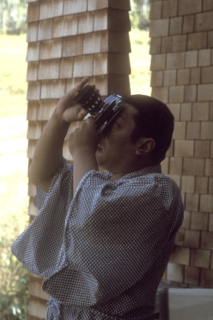Chögyam Trungpa Rinpoche and the Origins of Contemplative Photography
 The Practice of Contemplative Photography presents an approach to photography that is grounded in Buddhist teachings on perception, creativity, and wisdom. The connection between Buddhism and photography might not be obvious, but Buddhists have studied the mind and heart and applied their understanding and practices to the challenges of life for more than twenty-five hundred years. Buddhism also has rich traditions of expressing wisdom and realization through the arts. Finally, and perhaps most important, photography and Buddhism share essential interests: both are concerned with clear seeing.
The Practice of Contemplative Photography presents an approach to photography that is grounded in Buddhist teachings on perception, creativity, and wisdom. The connection between Buddhism and photography might not be obvious, but Buddhists have studied the mind and heart and applied their understanding and practices to the challenges of life for more than twenty-five hundred years. Buddhism also has rich traditions of expressing wisdom and realization through the arts. Finally, and perhaps most important, photography and Buddhism share essential interests: both are concerned with clear seeing.
Buddhism is concerned with clear seeing because clear seeing is the ultimate antidote for confusion and ignorance. Attaining liberation from confusion and ignorance is Buddhism’s raison d’être. Clear seeing is a primary concern for the art of photography because clear seeing is the source of vivid, fresh images—photography’s raison d’être.
The particular confluence between Buddhism and photography that led to The Practice of Contemplative Photography began in the middle of the last century, when Chögyam Trungpa Rinpoche, the eleventh incarnation of one of the highest lamas in eastern Tibet, got his first camera. Trungpa Rinpoche took his first photograph when he was fifteen. Four years later, he fled his homeland to escape the Chinese takeover, leading a group of refugees across the Himalayas to safety in India.
In 1963 he traveled to England to study comparative religion and philosophy at Oxford University. He later wrote, “I had to immerse myself thoroughly in everything, from the doctrines of Western religion up to the way people tied their shoelaces.” Intrigued by his exposure to Western and Japanese art, he began to explore ways the camera could be used to create images of the world of form: the naked appearance of things, before they are overlaid with any conceptions about what they mean or what they are.
After Oxford, Trungpa Rinpoche founded the first Tibetan Buddhist meditation center in the West in the rolling hills of Dumfriesshire, Scotland. Within a few years, he moved to America, attracted by the fertile spiritual ground of its teeming, exuberant culture.
In America he presented the wisdom of the Buddhist tradition in contemporary idioms and examples. He worked with Western cultural forms to train his students, launching projects in film, theater, and psychotherapy. He used photography and other art forms to express the experience of the awakened state of mind.
Both Andy and Michael became students of Trungpa Rinpoche in the 1970s, and were profoundly influenced by him.

